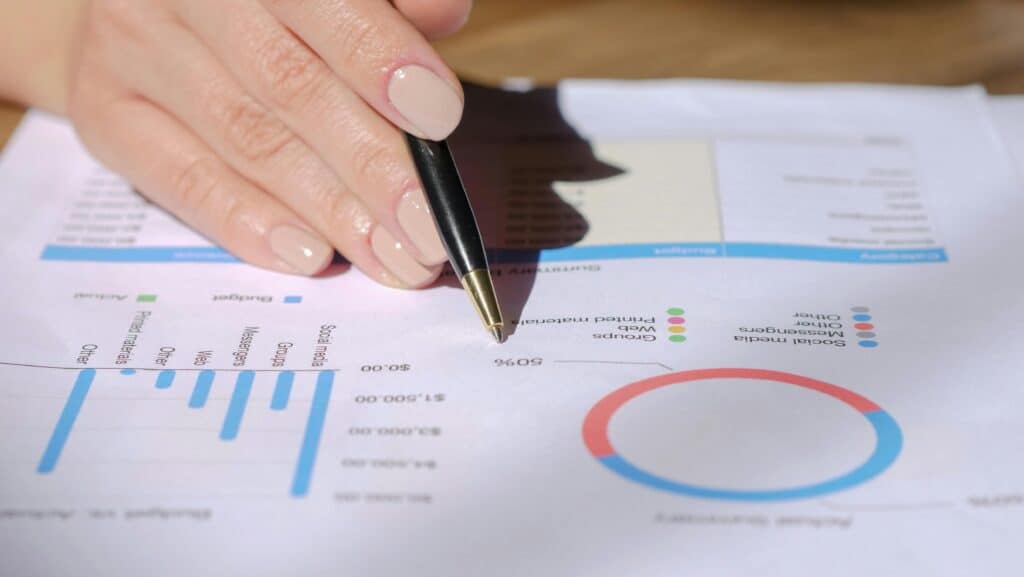Keeping your business running smoothly often comes down to one thing: managing your cash.
Even if your sales look good on paper, a lack of available cash can cause real problems, such as missed payroll, late payments, or missed opportunities to grow. That’s why cash flow forecasting matters.
Knowing how to forecast cash flow helps you stay ahead of slow periods, plan your spending, and avoid last-minute scrambles for money. If you are a startup or have been running your business for years, regularly forecasting your cash flow can help you make smarter decisions and avoid common financial mistakes.
What Is Cash Flow Forecasting?
Put simply, cash flow forecasting involves determining how much money is expected to come in and out of your business over time. This gives you a clearer picture of what your bank balance might look like in the weeks or months ahead.
There are two main types:
- Short-term forecasts: These usually cover the next few weeks or months. They help you manage daily spending and make sure you can pay your bills on time.
- Long-term forecasts: These look six months to a year ahead (or more) and help with bigger cash flow planning, like hiring, investing in equipment, or deciding when to launch a new product.
What Goes Into a Cash Flow Forecast?
To build a cash flow forecast, you’ll need to think about both the money coming in and the money going out.
- Cash Inflows: These are the funds your business receives from different sources. A cash inflow includes money from sales, payments from customers (accounts receivables), and funds from loans or credit lines.
- Cash Outflows: These are the regular expenses your business needs to maintain its operations. Cash outflows include rent, payroll, supplies, loan repayments, and utility bills.

Why Is Cash Flow Forecasting Important for Your Business?
Understanding where your money comes from and where it goes is only part of the picture. What really makes a difference is how you use that information to plan ahead.
Spotting Cash Gaps Early
Forecasting enables you to identify cash shortages before they occur. If it appears that you’ll run low on funds in a few months, you have time to prepare, whether that means cutting costs, adjusting your plans, or lining up financing.
Planning for Seasonal Fluctuations
Many businesses have busy and slow times during the year. A florist, for example, may see big spikes around holidays, while a landscaping company might have a quiet winter. Forecasting helps with financial planning, allowing you to set aside money during strong months to cover slower periods.
Making Strategic Business Decisions
If you’re considering hiring a new person or launching a marketing campaign, your forecast can help you determine if the timing is financially viable. Having a clear view of your future cash position gives you more confidence when making decisions.
How to Forecast Cash Flow: A Step-by-Step Guide
Here are the steps in cash flow forecasting:
1. Gather Historical Financial Data
Start by reviewing your past income and spending. Go through your monthly financial reports and bank statements from the last 6 to 12 months. This provides a clear view of how money flows through your business, helping you identify patterns, such as seasonal spikes, recurring costs, and the highs and lows of cash flow over time.
2. Estimate Future Cash Inflows
Next, look at where you expect money to come from. Use recent sales figures to estimate upcoming revenue and factor in any outstanding customer payments. You should also include any loan funds, grants, or investor contributions you expect to receive. Try to be realistic, especially with sales projections; overestimating can lead to cash shortages later.
3. Project Cash Outflows
Now, turn your attention to upcoming expenses. Start with fixed costs, such as rent, loan payments, and regular payroll, which tend to remain the same each month. Then add variable costs, things like:
- Inventory
- Shipping
- Seasonal Labor
These can change depending on your business activity. Be sure also to include taxes, utilities, insurance, and any other operating expenses that could impact your cash flow.
4. Calculate Net Cash Flow
Once you’ve listed all expected inflows and outflows, subtract the outflows from the inflows. This tells you your projected net cash flow for the period. If the number is positive, you’re bringing in more than you’re spending. If it’s negative, you may need to take action, like cutting costs or finding additional funding, to avoid running short.
5. Adjust Assumptions Regularly
Things rarely go exactly as planned, so it’s a good idea to revisit your forecast often. Sales might dip, expenses could rise, or payments may come in later than expected. Keeping your forecast up to date helps you stay flexible and make informed decisions as things change. A quick review each week or month can go a long way toward staying on track.

What Are the Cash Flow Forecasting Best Practices?
Once you’ve created a forecast, the way you manage and update it plays a big role in overall financial management. A few simple habits can help keep your forecast accurate, useful, and aligned with how your business actually runs.
Use Realistic Assumptions Based on Data
Try to avoid guessing or relying too much on best-case scenarios. Use actual data from your financial reports to set your estimates, especially for sales and expenses. If you’re unsure about a number, it’s better to be conservative. This approach helps reduce surprises and provides you with more flexibility to adjust if something changes.
Update Forecasts Regularly (Monthly or Weekly)
Your forecast shouldn’t sit untouched for months at a time. Even small changes in sales or expenses can skew your numbers, so aim to review and adjust your forecast regularly, on a weekly or monthly basis, depending on the pace of your business. This habit makes it easier to address issues early and helps you make better short-term decisions.
Align Cash Flow Forecasts With Business Goals and Budgets
Your cash flow forecast should reflect your overall goals and spending priorities. If you’re planning to hire, launch a product, or expand your space, make sure that’s accounted for in the numbers.
Using your financial knowledge in this way helps keep decisions grounded and prevents confusion later on.
Collaborate Across Departments
Cash flow touches almost every part of your business. People in sales, operations, and even customer service often have insights that can improve your projections. Bringing in their input can help you spot upcoming changes or risks earlier. It also encourages better communication across departments.
Create Multiple Scenarios
Things don’t always go as expected, so it helps to prepare for more than one possible outcome. You can build several versions of your forecast: one for steady growth, one in case sales slow down, and another in case things pick up quickly. This gives you more flexibility and helps you respond more quickly when things change.
Integrate with an Accounting Software
Modern accounting tools often include features to help with forecasting. These tools can extract data from your books and automatically create reports, saving you time and reducing manual errors. While you still need to review and adjust the numbers, software can make the process more efficient.
Consider Hiring a Professional
If managing your forecast feels overwhelming or you don’t have the time, outside support can be a valuable resource. This might involve hiring a Fractional CFO or an Outsourced Controller, and utilizing a service like The A Team’s AccountingIQ Software Solutions Practice.
4 Common Mistakes in Cash Flow Forecasting
Even with a solid plan, cash flow forecasts can quickly become inaccurate if a few common issues slip in. Knowing what to watch out for can help you avoid shortfalls and stay on track.
- Overestimating Revenue: It’s easy to be overly hopeful when projecting future sales, especially if things have been going well lately. But if those numbers don’t materialize, your business could end up short on cash.
- Ignoring One-Time or Seasonal Expenses: Some costs don’t show up every month, which makes them easy to miss. Annual insurance renewals, one-off equipment repairs, or seasonal bonuses can throw off your cash flow if you haven’t planned for them.
- Forgetting Tax Obligations or Debt Repayments: Loan repayments and taxes often fall into a “set it and forget it” category, but they can seriously affect your available cash if overlooked.
- Not Revisiting and Revising Forecasts Frequently: A forecast only helps if you keep it up to date. If it’s not revised regularly, it won’t reflect what’s really happening in your business.
Take Control With Smart Cash Flow Forecasting Today
Keeping an eye on your cash flow helps you stay grounded in what’s really happening in your business. A solid and flexible forecast gives you more clarity, helps you plan with more confidence, and makes it easier to adjust when things shift.
If you want help building or maintaining your forecast, our Fractional CFO services can help you set up simple, reliable processes and help you use the numbers to make day-to-day decisions with less guesswork.
Cash Flow Forecasting FAQs
Here are a few common questions that often arise in cash flow forecasting:
How often should I update my cash flow forecast?
Most businesses benefit from checking their forecast at least once a month. If your cash flow fluctuates frequently or you’re experiencing rapid growth, consider scheduling weekly updates.
What if my forecast shows a shortfall? What should I do next?
Don’t panic and start planning. You might consider cutting back on spending, collecting payments more quickly, delaying non-urgent purchases, or consulting with your bank or lenders early.
Is cash flow forecasting useful for new businesses?
Yes. Even if you don’t have much financial history, you can build a forecast based on what you know so far and adjust as you go.
How do I handle unexpected expenses in my cash flow forecast?
Try adding a “buffer” each month and set aside a small amount for unexpected expenses. That way, your forecast can still hold up if something unexpected happens.

